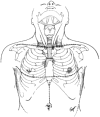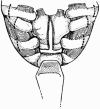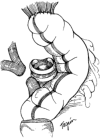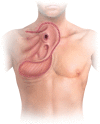Cervical exenteration
- PMID: 29707499
- PMCID: PMC5900087
- DOI: 10.21037/acs.2018.03.05
Cervical exenteration
Abstract
Cervical exenteration is a radical procedure for the treatment of locally invasive cancers of the trachea, esophagus, or thyroid, as well as recurrent tumors at the site of a tracheal stoma, and occasionally for benign disease. Exenteration involves removal of the larynx, pharynx, esophagus, and trachea, as well as associated lymphatic tissue. The tracheal stump is brought up as a cervical or mediastinal tracheostomy, depending on the length and the location of the distal resection site. The alimentary tract can be reconstructed with several types of conduits, but most commonly the stomach or left colon are used. Tension on the innominate artery must be avoided when repositioning the trachea to prevent innominate artery erosion. Tension on the artery can be addressed by either dividing the vessel or by transposing the trachea inferior and lateral to the innominate artery and vein. Overall, cervical exenteration is associated with a significant risk of morbidity, including anastomotic leak, innominate artery erosion, and tracheostomy dehiscence with subsequent mediastinitis, as well as the potential for postoperative death. Nevertheless, in highly selected patients, it can provide an unparalleled opportunity for either cure or palliation, with functional results equivalent to that of total laryngectomy.
Keywords: Mediastinal tracheostomy; aortic homograft; conduit; reconstruction; skin flap.
Conflict of interest statement
Conflicts of Interest: The authors have no conflicts of interest to declare.
Figures









References
-
- LoGiudice JA, Wyler von Ballmoos MC, Gasparri MG, et al. When the Gastrointestinal Conduit for Total Esophageal Reconstruction Is Not an Option: Review of the Role of Skin Flaps and Report of Salvage With a Single-Stage Tubed Anterolateral Thigh Flap. Ann Plast Surg 2016;76:463-7. 10.1097/SAP.0000000000000389 - DOI - PubMed
-
- Fleisher LA, Fleischmann KE, Auerbach AD, et al. 2014 ACC/AHA guideline on perioperative cardiovascular evaluation and management of patients undergoing noncardiac surgery: a report of the American College of Cardiology/American Heart Association Task Force on practice guidelines. J Am Coll Cardiol 2014;64:e77-137. 10.1016/j.jacc.2014.07.944 - DOI - PubMed
Publication types
LinkOut - more resources
Full Text Sources
Other Literature Sources
